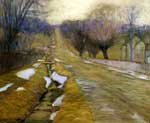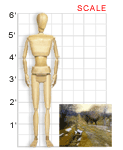From the collection of:
University of Kentucky Art Museum || VAM Home
Edward Willis Redfield (American, 1869-1925)
BUCKS COUNTY WINTER, 1898
Oil on canvas; 24-1/4" X 29-1/2"
Gift of Mattie Schmidt Bowyer in memory of her husband, Charles Henry Bowyer, 46.1.12
University of Kentucky Art Museum
Bucks County Winter is a view near Edward Redfield’s home at New Hope, Pennsylvania. Its diffuse light of twilight and restrained color scheme are typical of the artist’s winter landscapes, which seem to dissolve amid the effects of light and weather.
Edward Redfield is known for wintry scenes such as this one. The artist first painted snowy landscapes while living in the Fontainebleau art colony in France, and the subject became his signature theme once he returned home to the United States. In true Impressionist fashion, Redfield painted Bucks County Winter (and all of his works, for that matter) en plein air, meaning outside, directly from nature. As evident in this golden-hued work, Redfield allowed a single, predominant “tone” to determine the mood of each painting.
About the Artist
A Delaware native, Edward Willis Redfield moved to Philadelphia as a youth and eventually studied at the Pennsylvania Academy of the Fine Arts. He then went to France to continue his art training at the Academie Julien in Paris. Redfield was quite taken with the French Impressionist movement, once recalling that his “gods were painters like Degas and Monet.” He married and returned to the United States, settling on a farm in rural Bucks County, Pennsylvania, near New Hope.
Although Redfield did not consider himself a member of the group and often declined to exhibit with them, he was actually regarded as the leader of an emerging group of Pennsylvania Impressionists known as the New Hope school of art.
While Redfield was highly regarded and successful in his lifetime, recent attention to his work has more firmly established his reputation as one of the most important American Impressionists in history.
Classroom Ideas
Discussion: What characteristics of this painting let you know that it is winter? What is the focal point? Is there anything about this painting that hints at the fact that it was painted from life and not a photograph? What objects are shown in the painting? Are any of them (such as the small house on the right) difficult to see? How does this painting compare to works by the more well-known Impressionists Degas and Monet?
Activities: Using oil pastels, watercolors, or colored pencils, select and draw an outdoor scene from a photograph or a magazine picture. Then, on a nice day, take your art supplies (paper, drawing board, and oil pastels) outside with you and draw a landscape en plein air. When you finish, discuss how your two drawings compare. Is one better than the other? Did you encounter any difficulties in working outdoors?
Choose a landscape scene and sketch the basic outline four times. Then, using oil pastels, watercolors, or colored pencils, color the landscape to show each of the four seasons. Pay attention to the lighting and consider that the sun is in different positions in the sky in different seasons.
Links
The profile of Redfield at the Outdoor Painting site includes examples of his work and a photograph of the artist.
[www.outdoorpainting.com/History/Edward-Redfield.php]
Read another biography of Redfield, including quotes from people that knew him, at Antiques and the Arts Online.
[www.antiquesandthearts.com/archive/red.htm]
See a variety of images of Redfield’s work at the James A. Michener Art Museum.
[www.michenerartmuseum.org/bucksartists/artist.php?artist=201]
Look up Redfield in the ArtCyclopedia for a comprehensive guide to online resources relating to the artist.
[www.artcyclopedia.com/artists/redfield_edward_willis.html]

